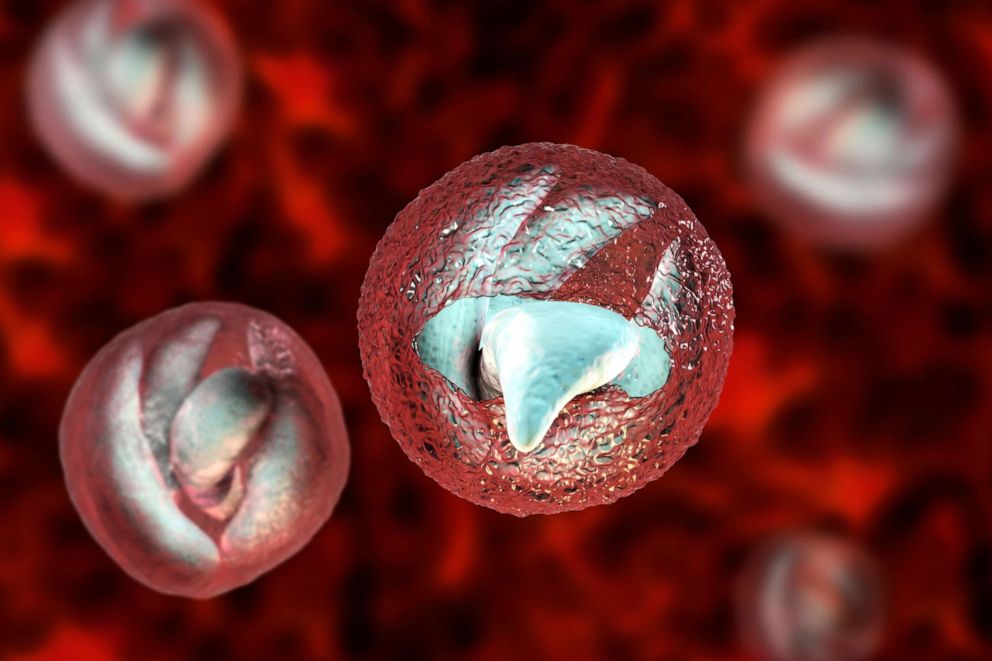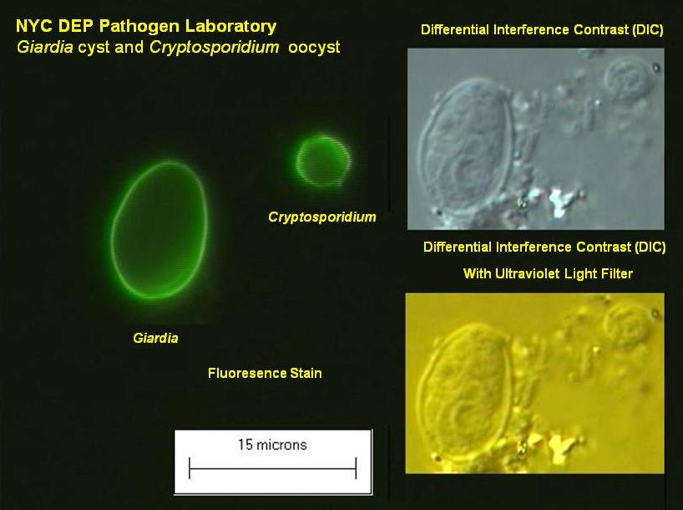Cryptosporidium Oocyst : Kostenlose Bild: Histopathologie, Kryptosporidiose ... / Cryptosporidiosis is a parasitic infection of the small intestine.. Cryptosporidiosis is caused by members of the genus cryptosporidium, a coccidian parasite in the family cryptosporidiidae, subclass cryptogregaria and phylum apicomplexa. The high resistance of cryptosporidium oocysts against chlorine disinfection korich et al., 1990; Oocysts of cryptosporidium from fecal flotation. Cryptosporidium parvum oocysts were examined to ascertain excystation requirements and the effects of gamma irradiation. Cryptosporidiosis is the infection in humans and animals with cryptosporidium spp., which are protozoan, obligate intracellular parasites.
Cryptosporidium oocysts have been found on the surface of fresh, raw vegetables obtained from retail markets (ortega et al., 1991; Oocysts of cryptosporidium from fecal flotation. Handbook of water and wastewater microbiology, 2003. Cryptosporidium parvum oocysts in seawater clams (chameleagallina) in italy. Cryptosporidium hominis, which primarily infects humans;

Diarrhea is the main symptom, but in people with compromised.
Oocysts and excysted sporozoites were examined for dye permeability. Sporozoites are sometimes visible inside the oocysts, indicating that sporulation has occurred. Two species are responsible for most human infections: Cryptosporidium hominis, which primarily infects humans; Cryptosporidium exists as several distinct species with different degrees of infectivity for animals and humans Handbook of water and wastewater microbiology, 2003. Ransome et al., 1993 renders this process ineffective for oocyst inactivation in. Cryptosporidium muris oocyst wall protein gene, partial cds. The high resistance of cryptosporidium oocysts against chlorine disinfection korich et al., 1990; Cryptosporidium parvum oocyst inactivation in three soil types at various temperatures and water potentials. Cryptosporidiosis is a parasitic disease that causes diarrhea. Cryptosporidiosis is the infection in humans and animals with cryptosporidium spp., which are protozoan, obligate intracellular parasites. Oocysts are rounded and measure 4.2 to 5.4 µm in diameter.
Diarrhea is the main symptom, but in people with compromised. Oocysts of cryptosporidium from fecal flotation. These were first discovered in mice in 1912 and first linked. Sporozoites are sometimes visible inside the oocysts, indicating that sporulation has occurred. Cryptosporidium, sometimes informally called crypto, is a genus of apicomplexan parasitic alveolates that can cause a respiratory and gastrointestinal illness (cryptosporidiosis) that primarily involves watery diarrhea (intestinal cryptosporidiosis) with or without a persistent cough.

Sporozoites are sometimes visible inside the oocysts, indicating that sporulation has occurred on wet mount.
Cryptosporidium hominis, which primarily infects humans; Oocysts and excysted sporozoites were examined for dye permeability. Cryptosporidiosis is the infection in humans and animals with cryptosporidium spp., which are protozoan, obligate intracellular parasites. Cryptosporidiosis is caused by members of the genus cryptosporidium, a coccidian parasite in the family cryptosporidiidae, subclass cryptogregaria and phylum apicomplexa. Sporozoites are sometimes visible inside the oocysts, indicating that sporulation has occurred on wet mount. Learn vocabulary, terms and more with flashcards, games and other study tools. Cryptosporidium parvum oocyst inactivation in three soil types at various temperatures and water potentials. The high resistance of cryptosporidium oocysts against chlorine disinfection korich et al., 1990; Cryptosporidium, sometimes informally called crypto, is a genus of apicomplexan parasitic alveolates that can cause a respiratory and gastrointestinal illness (cryptosporidiosis) that primarily involves watery diarrhea (intestinal cryptosporidiosis) with or without a persistent cough. Cryptosporidiosis is a parasitic disease that causes diarrhea. These were first discovered in mice in 1912 and first linked. Cryptosporidium parvum oocysts were examined to ascertain excystation requirements and the effects of gamma irradiation. Cryptosporidium exists as several distinct species with different degrees of infectivity for animals and humans
Sporozoites are sometimes visible inside the oocysts, indicating that sporulation has occurred. Cryptosporidium oocysts have been found on the surface of fresh, raw vegetables obtained from retail markets (ortega et al., 1991; Cryptosporidium, sometimes informally called crypto, is a genus of apicomplexan parasitic alveolates that can cause a respiratory and gastrointestinal illness (cryptosporidiosis) that primarily involves watery diarrhea (intestinal cryptosporidiosis) with or without a persistent cough. Cryptosporidium exists as several distinct species with different degrees of infectivity for animals and humans Cryptosporidiosis is caused by members of the genus cryptosporidium, a coccidian parasite in the family cryptosporidiidae, subclass cryptogregaria and phylum apicomplexa.

Cryptosporidium parvum oocyst inactivation in three soil types at various temperatures and water potentials.
Diarrhea is the main symptom, but in people with compromised. Sporozoites are sometimes visible inside the oocysts, indicating that sporulation has occurred. The high resistance of cryptosporidium oocysts against chlorine disinfection korich et al., 1990; Sporozoites are sometimes visible inside the oocysts, indicating that sporulation has occurred on wet mount. Cryptosporidium parvum oocysts in seawater clams (chameleagallina) in italy. Cryptosporidiosis is a parasitic disease that causes diarrhea. Handbook of water and wastewater microbiology, 2003. Oocysts and excysted sporozoites were examined for dye permeability. Oocysts are rounded and measure 4.2 to 5.4 µm in diameter. Cryptosporidium, sometimes informally called crypto, is a genus of apicomplexan parasitic alveolates that can cause a respiratory and gastrointestinal illness (cryptosporidiosis) that primarily involves watery diarrhea (intestinal cryptosporidiosis) with or without a persistent cough. Cryptosporidiosis is a parasitic infection of the small intestine. Cryptosporidium parvum oocyst inactivation in three soil types at various temperatures and water potentials. These were first discovered in mice in 1912 and first linked.
Cryptosporidiosis is the infection in humans and animals with cryptosporidium spp, which are protozoan, obligate intracellular parasites cryptosporidium. Cryptosporidiosis is caused by members of the genus cryptosporidium, a coccidian parasite in the family cryptosporidiidae, subclass cryptogregaria and phylum apicomplexa.
Konversi Kode